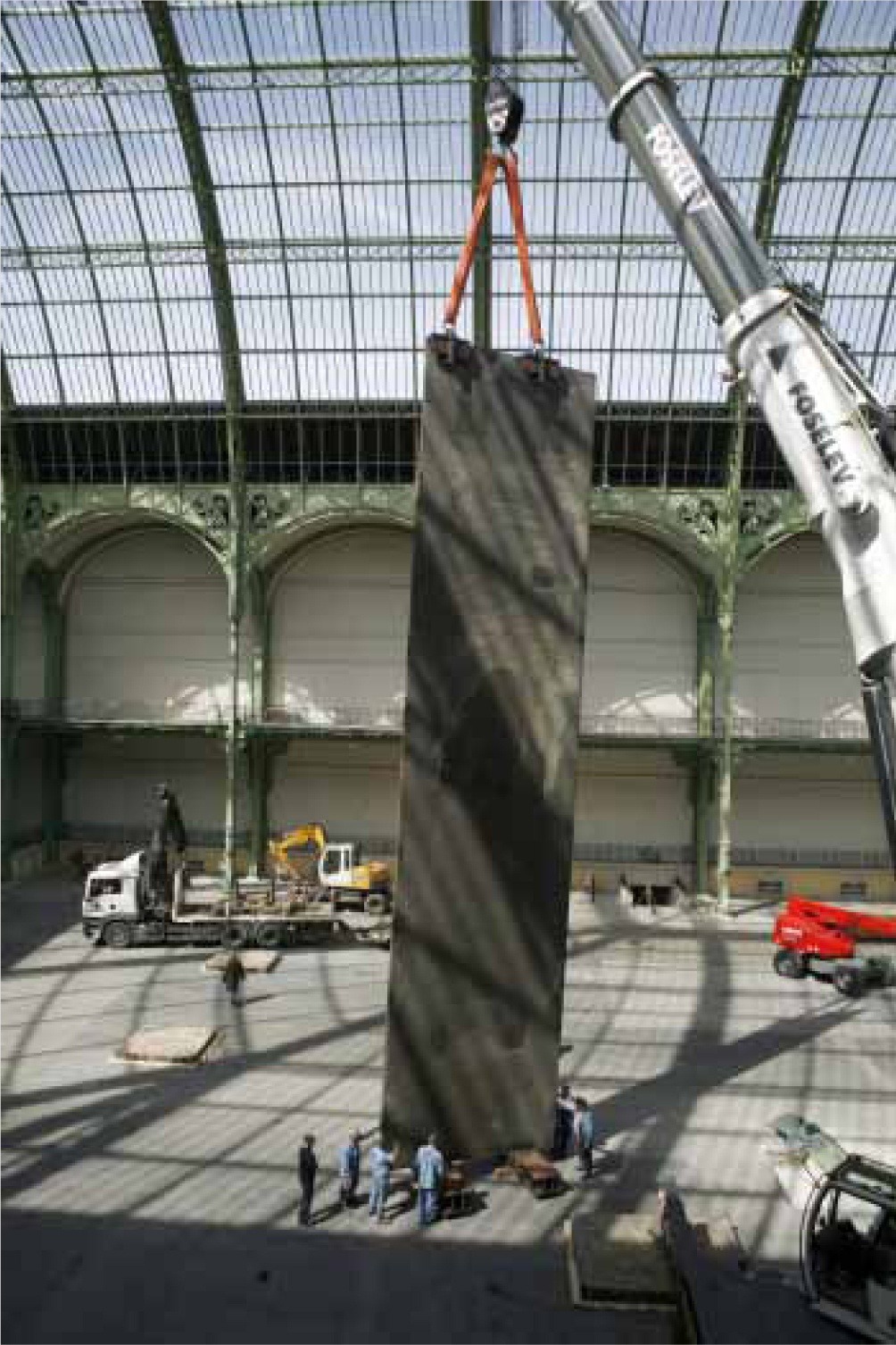Tour de force: Richard Serra’s huge ‘Promenade’ is erected in Paris’ Grand Palais as part of the annual Monumenta exhibition, 2008.
Correct me if I’m wrong, but an artist has not, as of yet, actually cured cancer – though many certainly behave as though they have.
I have never met him, but from what I know, legendary American sculptor Richard Serra could be one such man. He is most famous for going off the rails when his installation, “Tilted Arc”, was removed from its moorings in Foley Square in downtown New York City in 1989. At the time I was a lawyer yo-yoing back and forth to court every day and, though I appreciated it, I could commiserate with the office workers who couldn’t stomach a curved slice of rusted, graffiti-laden metal dissecting their outdoor lunching space. Serra spent years on a soapbox kicking and screaming, trying to initiate Federal Law to halt the removal.
In another instance of megalomania, a Serra piece was auctioned in London with the proviso that the work was sold subject to the artist and the buyer agreeing on the site for the sculpture and the manner and position in which it was to be displayed. So, thrown into the deal, you get a personal audience with the supreme, bullheaded artist who shows up on your doorstep. If the angry master is not convinced of your choices, then the deal is off (it sold for around £1.5m).
I admire the work of photographer Cindy Sherman, subject of a recent retrospective at the Museum of Modern Art in New York – or at least I think I do. But on a certain level I don’t get past the incessant navel-gazing of relentlessly dressing up and taking hundreds (thousands?) of selfportrait images for decades on end. Though the market has affirmed, over and over, that it is as enamoured with Sherman’s likeness as she is, whenever she goes off-piste and turns the camera away from herself, the art world turns away too.
As much as I also hate kids, their artwork is at least up to snuff with a lot of their adult peers and, in some cases, better. Together with my 14- and 15-year-old children, I recently curated an exhibition, Friends & Family, made up of artists such as Damien Hirst, upand-coming talents and the works of a group of school friends.
The project was an example of the way of thinking that says anyone can be an artist, or at least experience what it feels like to be one, from my mechanic, to my kids and their Facebook friends. And anything can be art.
Almost predictably, we had a little Tracey Emin incident that received worldwide coverage from a full-page Evening Standard story to an article in Pakistan’s Daily Times. The night went superbly, with a smattering of celebrities, musical performances and a seamless art installation, when, in the last minutes of a five-hour opening, a teen with known “adrenaline issues” had a confrontation with a pedestal and the Emin sculpture perched atop it. The Evening Standard headline screamed: “Breakdancer: Party Girl Sends Emin Art Flying”. So I became the reckless Family Guy who let his kids throw a rave in a gallery full of art, and my kids, who spent eight months organising an exhibition and catalogue, nihilistic scoundrels. I love Tracey and understand her – I think – but, considering the enormous effort the children put in, it wasn’t exactly in the spirit of it all to remove her works, which she did, both damaged and undamaged.
Over the years, some of the artists I exhibited prior to their representation by galleries became quite well known or, should I say, expensive – Fred Tomaselli, Cecily Brown, Janine Antoni and Wade Guyton among them. Invariably, I was later crossed off the CVs of many; when an artist succeeds they get a licence to print money which can bring about drastic character changes, even in the people you’d least expect it to.
Los Angeles artist Mark Grotjahn sold a work that was bought by TV producer Dean Valentine, who later resold it for a healthy profit. California, like most of Europe, employs droit de suite, or the “right to follow”, meaning an artist has the continuing right to prosper from sales of their works at the expense of the seller. Grotjahn sued and won a judgement of around £100,000 (although the law has since been overturned). Personally, I don’t care if you are buying a Pablo Picasso or a Jane Doe – when a collector purchases art, they make a leap of faith knowing full well that 99 per cent of all art sold will have no resale value.
I have an extremely close relationship with the shifting group of artworks I live with – not a day goes by that I don’t press my nose against one particular piece or another in my house, and I have worked hand in hand with artists from day one. But over the years you begin to appreciate artists’ estates more than the living, breathing variety. I guess I don’t really hate artists – I’m obsessed with art and it has to get made somehow.
When Stuart the mechanic saw the exhibition I curated with the kids, his reaction was, “It sure is crammed full of stuff.” It was only his first show and he had already turned his newly artistic nose up at my curatorial methods. Long live (annoying) artists.
Kenny Schachter

